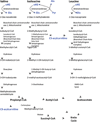Interplay between lipids and branched-chain amino acids in development of insulin resistance - PubMed (original) (raw)
Review
Interplay between lipids and branched-chain amino acids in development of insulin resistance
Christopher B Newgard. Cell Metab. 2012.
Abstract
Fatty acids (FA) and FA-derived metabolites have long been implicated in the development of insulin resistance and type 2 diabetes. Surprisingly, application of metabolomics technologies has revealed that branched-chain amino acids (BCAA) and related metabolites are more strongly associated with insulin resistance than many common lipid species. Moreover, the BCAA-related signature is predictive of incident diabetes and intervention outcomes and uniquely responsive to therapeutic interventions. Nevertheless, in animal feeding studies, BCAA supplementation requires the background of a high-fat diet to promote insulin resistance. This Perspective develops a model to explain how lipids and BCAA may synergize to promote metabolic diseases.
Copyright © 2012 Elsevier Inc. All rights reserved.
Figures
Figure 1. Pathways of branched-chain amino acid catabolism
Shown in blue are the reactions that produce metabolites found in the BCAA-related principal component that associates with insulin resistance and other metabolic diseases.
Figure 2. Acylcarnitines in skeletal muscle in rats fed on various diets for 12 weeks
SC, standard chow, SC/BCAA, standard chow supplemented with branched-chain amino acids (Val, Leu, Ile); HF, high fat diet (35% calories from fat); HF/BCAA, HF diet supplemented with branched-chain amino acids. Inset. C3 and C5 acylcarnitines in rats fed on various diets. Data adapted from Newgard, et al., 2009.
Figure 3. Schematic working model of potential cross-talk between lipids and BCAA in development of obesity-related insulin resistance
See text for details. “Anaplerosis” refers to repletion or filling up of TCA cycle intermediates via entry points other than acetyl CoA. TG, triglyceride; IMTG, intramyocellular triglyceride; IR, insulin receptor.
Similar articles
- Diabetes and branched-chain amino acids: What is the link?
Bloomgarden Z. Bloomgarden Z. J Diabetes. 2018 May;10(5):350-352. doi: 10.1111/1753-0407.12645. Epub 2018 Feb 13. J Diabetes. 2018. PMID: 29369529 - Branched Chain Amino Acids in Metabolic Disease.
Arany Z, Neinast M. Arany Z, et al. Curr Diab Rep. 2018 Aug 15;18(10):76. doi: 10.1007/s11892-018-1048-7. Curr Diab Rep. 2018. PMID: 30112615 Review. - Cross-talk between branched-chain amino acids and hepatic mitochondria is compromised in nonalcoholic fatty liver disease.
Sunny NE, Kalavalapalli S, Bril F, Garrett TJ, Nautiyal M, Mathew JT, Williams CM, Cusi K. Sunny NE, et al. Am J Physiol Endocrinol Metab. 2015 Aug 15;309(4):E311-9. doi: 10.1152/ajpendo.00161.2015. Epub 2015 Jun 9. Am J Physiol Endocrinol Metab. 2015. PMID: 26058864 Free PMC article. Clinical Trial. - A branched-chain amino acid-related metabolic signature that differentiates obese and lean humans and contributes to insulin resistance.
Newgard CB, An J, Bain JR, Muehlbauer MJ, Stevens RD, Lien LF, Haqq AM, Shah SH, Arlotto M, Slentz CA, Rochon J, Gallup D, Ilkayeva O, Wenner BR, Yancy WS Jr, Eisenson H, Musante G, Surwit RS, Millington DS, Butler MD, Svetkey LP. Newgard CB, et al. Cell Metab. 2009 Apr;9(4):311-26. doi: 10.1016/j.cmet.2009.02.002. Cell Metab. 2009. PMID: 19356713 Free PMC article. - The role of branched-chain amino acids and their downstream metabolites in mediating insulin resistance.
Abdualkader AM, Karwi QG, Lopaschuk GD, Al Batran R. Abdualkader AM, et al. J Pharm Pharm Sci. 2024 Jun 28;27:13040. doi: 10.3389/jpps.2024.13040. eCollection 2024. J Pharm Pharm Sci. 2024. PMID: 39007094 Free PMC article. Review.
Cited by
- Blood-Derived Lipid and Metabolite Biomarkers in Cardiovascular Research from Clinical Studies: A Recent Update.
Kale D, Fatangare A, Phapale P, Sickmann A. Kale D, et al. Cells. 2023 Dec 8;12(24):2796. doi: 10.3390/cells12242796. Cells. 2023. PMID: 38132115 Free PMC article. Review. - Diet, Microbiota, Obesity, and NAFLD: A Dangerous Quartet.
Machado MV, Cortez-Pinto H. Machado MV, et al. Int J Mol Sci. 2016 Apr 1;17(4):481. doi: 10.3390/ijms17040481. Int J Mol Sci. 2016. PMID: 27043550 Free PMC article. Review. - BCATc inhibitor 2 ameliorated mitochondrial dysfunction and apoptosis in oleic acid-induced non-alcoholic fatty liver disease model.
Lu Z, Sun GF, Pan XA, Qu XH, Yang P, Chen ZP, Han XJ, Wang T. Lu Z, et al. Front Pharmacol. 2022 Oct 28;13:1025551. doi: 10.3389/fphar.2022.1025551. eCollection 2022. Front Pharmacol. 2022. PMID: 36386234 Free PMC article. - Metabolic profiling for detection of Staphylococcus aureus infection and antibiotic resistance.
Antti H, Fahlgren A, Näsström E, Kouremenos K, Sundén-Cullberg J, Guo Y, Moritz T, Wolf-Watz H, Johansson A, Fallman M. Antti H, et al. PLoS One. 2013;8(2):e56971. doi: 10.1371/journal.pone.0056971. Epub 2013 Feb 25. PLoS One. 2013. PMID: 23451124 Free PMC article. - Abdominal obesity in COPD is associated with specific metabolic and functional phenotypes.
Cruthirds CL, Deutz NEP, Mizubuti YGG, Harrykissoon RI, Zachria AJ, Engelen MPKJ. Cruthirds CL, et al. Nutr Metab (Lond). 2022 Dec 1;19(1):79. doi: 10.1186/s12986-022-00714-z. Nutr Metab (Lond). 2022. PMID: 36457012 Free PMC article.
References
- Boucher A, Lu D, Burgess S, Telemaque-Potts S, Jensen M, Mulder H, Wang M-Y, Unger RH, Sherry AD, Newgard CB. Mechanism of lipid-induced impairment of glucose-stimulated insulin secretion and its reversal by an analogue of malate. J. Biol. Chem. 2004;279:27263–27271. - PubMed
- Clifton P. Diabetes: treatment of type 2 diabetes mellitus with bariatric surgery. Nature Rev. Endocrinol. 2010;6:191–193. - PubMed
- Cota D, Proulx K, Smith KA, Kozma SC, Thomas G, Woods SC, Seeley RJ. Hypothalamic mTOR signaling regulates food intake. Science. 2006;312:927–930. - PubMed
Publication types
MeSH terms
Substances
LinkOut - more resources
Full Text Sources
Other Literature Sources


